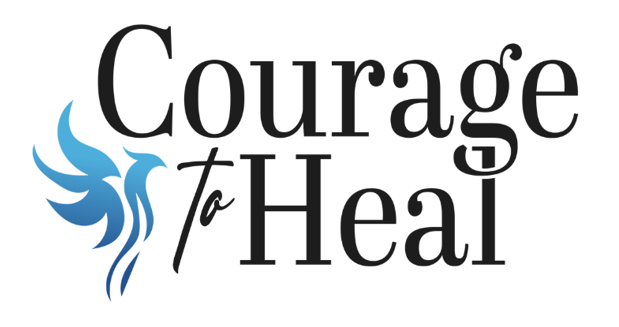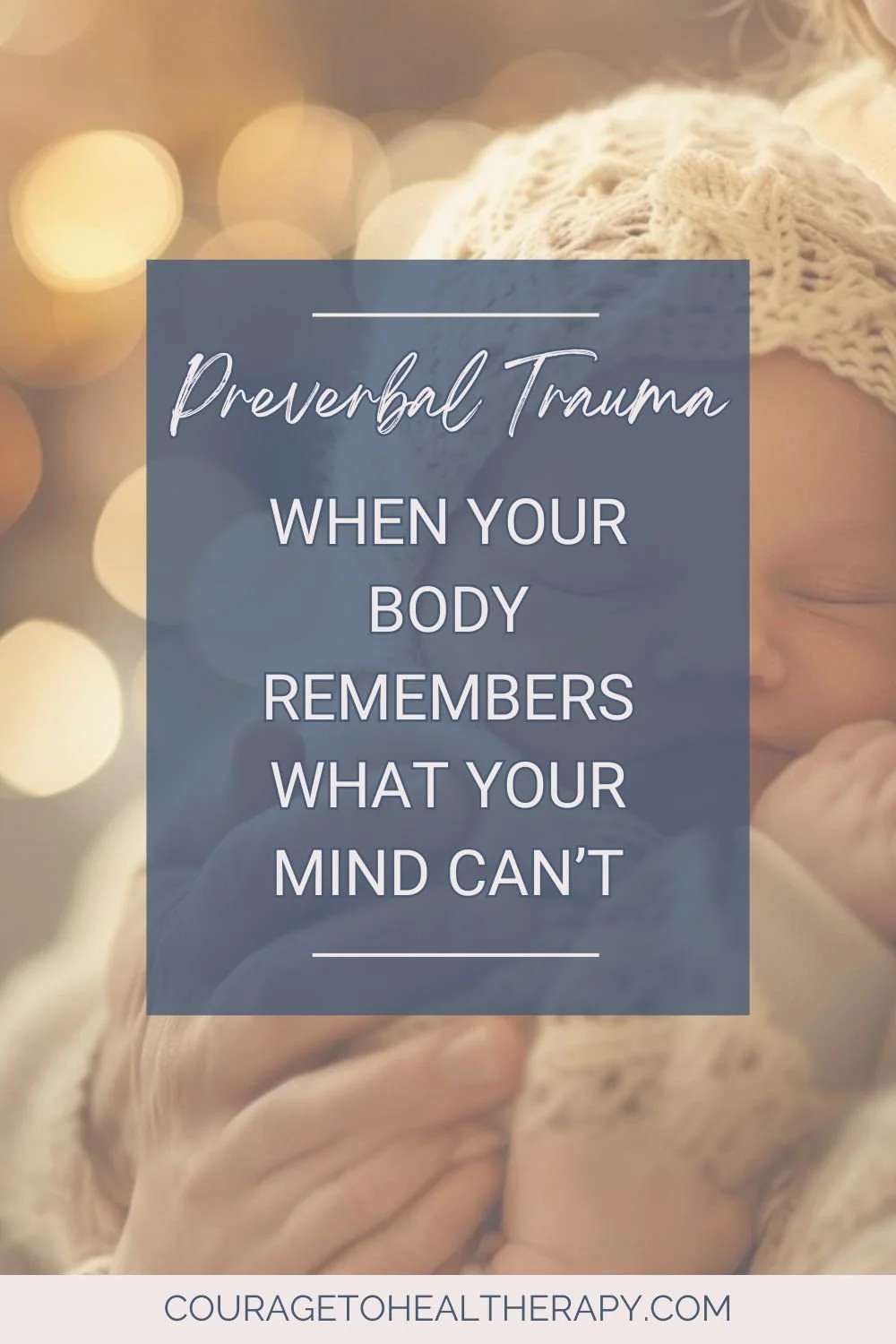Preverbal Trauma: When Your Body Remembers What Your Mind Can’t
Have you ever felt a wave of fear or tension in your body without any clear reason why? Maybe your heart races during a simple conversation, or you find yourself emotionally shutting down even around people you trust.
These confusing reactions can leave you wondering what’s wrong — and feeling alone in your struggle. But what if there’s a deeper explanation? Preverbal trauma could be the missing piece.
Long before we had words to describe our experiences, our bodies were already learning, adapting, and protecting us. Even if you can’t consciously remember those early moments, your nervous system hasn’t forgotten.
You're not being dramatic. You're not broken. There may be a very real reason for what you’re feeling. And here’s the hopeful part: what’s held in the body can also be healed.
What Is Preverbal Trauma?
You may not remember it with words or pictures, but your body does.
Preverbal or non-verbal trauma refers to experiences that occur before you had the language to understand or express what was happening. These early events – sometimes invisible to our adult minds – can leave behind a residue of pain, confusion, or physical symptoms that don't quite make sense.
Instead of clear memories that are more common with traditional PTSD or Complex PTSD, they show up as tension in your body, trouble with emotions, or the sense that something is “off” inside.
This kind of trauma isn’t imaginary. It’s stored in your nervous system, not as a story, but as sensation.
How Early Trauma Hides in the Body
When trauma happens in infancy or early childhood – before speech or cognitive awareness – there's no neat storyline for your brain to organize. What remains are flashes, fragments, or physical discomfort. You might notice the following preverbal trauma signs:
Disconnected sensory flashes
Vague dread or unease without a cause
Unexplained physical pain or chronic symptoms
Dr. Allan Schore, a renowned psychologist and neuroscientist, describes these early memories as motor patterns and emotional imprints: blueprints of our earliest relationships.
So, if you’ve ever wondered, “Why do I feel this way when nothing’s wrong?” – you’re not alone.
Examples of Preverbal or Non-verbal Trauma
These traumatic events often stem from what researchers call Adverse Childhood Experiences (ACEs). But when they happen very early, before speech, they don’t always get labeled as trauma, even though they may be stored just as intensely in the body.
Common causes include:
Complications during pregnancy or birth
Neonatal surgeries or medical trauma
Parental separation or neglect
Emotional unavailability
Physical, emotional, or sexual abuse
Exposure to domestic violence
Substance exposure in utero
Even events that were not “traumatic” in the adult sense, like long hospital stays or being held in the NICU after birth, can register in a baby’s body as overwhelming.
Signs of Preverbal Trauma in Adults
These early imprints can show up in adulthood in ways that seem mysterious at first. You might see preverbal trauma symptoms like:
Emotional Dysregulation
Feeling “too much” or “not enough” emotionally, seemingly out of nowhere. This includes anxiety, mood swings, or shutdown responses.
Cognitive Struggles
Trouble focusing, learning, or making decisions. It’s not about intelligence – it’s about survival wiring.
Behavioral Reactions
Impulsivity, self-isolation, or intense fear of abandonment. Your nervous system may be trying to protect you from an invisible threat.
Physical Symptoms
Unexplained chronic conditions like fatigue, digestive issues, or body pain. These might be the body’s way of holding unresolved stress.
Relationship Difficulties
Preverbal injuries often affects how you attach to others. You may crave closeness but fear it too. You may feel unworthy, even if you’re deeply loved.
While this is not an exhaustive list of preverbal trauma symptoms, it’s a good start for your to explore.
Can You Heal Trauma You Don’t Remember?
Yes. But not by forcing yourself to remember.
Preverbal memories don’t need to be re-lived to be resolved. They need to be felt – gently, safely, in your body.
Psychologist Arthur Janov called these imprints “somatic flashbulbs,” held not in our thoughts but in our cells. While memory is imperfect and malleable, the body remembers what the mind cannot.
Healing starts by restoring felt safety. That’s why the first stage of trauma therapy is stabilization: building trust, calming the body, and creating a container strong enough to hold what’s coming up.
Only after stabilization can you start processing the painful events that led to the formation of your symptoms.
How to Heal Preverbal Trauma
Since trauma lives in the body, healing preverbal trauma must happen through the body.
Gentle, effective approaches work best for addressing trauma that happens before explicit memories can be formed, such as:
Somatic Psychotherapy: Reconnecting with your body’s sensations in a safe and titrated way.
EMDR (Eye Movement Desensitization and Reprocessing) Therapy: The Preverbal Protocol Developed by Sandra Paulsen, this approach helps reprocess early memories stored as emotional or sensory fragments.
Parts Work (Internal Family Systems and Ego States Therapy): Honoring the protective roles of different parts of your psyche and meeting them with compassion.
Comprehensive Resource Model: Cultivating inner resources with attachment figures and somatic work before touching any trauma content.
This isn’t about “fixing” you. It’s about helping your body unburden what it’s been holding all these years.
Does EMDR Work for Preverbal Trauma?
I often get this question from people who have heard of EMDR as it's recently gained a lot of popularity.
When it comes to healing preverbal trauma, traditional talk therapy can only take you so far. If the trauma happened before you had words—or even before you were born—it’s not stored as a story you can easily tell.
As we already established, it’s stored in your body: in your muscles, your breath, your gut. So how do you work with something you can’t remember?
That’s where EMDR therapy offers a gentle yet powerful path forward.
Most people think of EMDR as a way to treat clear, specific memories. And that’s true. But when you’re working with preverbal trauma, there usually aren’t those kinds of memories to begin with. You’re not recalling events—you’re feeling them. That might look like tension, fear, fogginess, or a sinking sensation you can’t quite name.
So instead of searching for memories, we start by building something far more important: safety.
Step One: Building a Safe Foundation
Before we touch any trauma, your therapist helps you create a strong foundation. This means:
Containment: learning how to set emotional boundaries so you don’t feel overwhelmed
Safe states: discovering what calm feels like in your body and how to return to it
Emotional resources: reconnecting with inner strength, even if you didn’t have those supports as a baby
This prep work isn’t fluff—it’s essential. Because early trauma often comes with a lack of inner resources, especially if neglect was part of your story. Without these stabilizers, working with preverbal trauma can feel like too much, too fast.
But when you feel safer in your body, your system begins to trust the process.
Step Two: Processing Without Words
Once you’ve built that internal sense of safety, EMDR gently invites your body to process what it’s been holding. You don’t need to recall a scene or a narrative. Instead, your therapist guides you to tune in to your felt sense—the physical and emotional sensations that arise in the present moment.
We go slow. We listen closely.
The process follows a developmental timeline, starting with the earliest periods of life—including in utero experiences. Your therapist helps your system revisit these times, but not to relive them. Instead, you’re offered imaginal resources—safe, nurturing images or experiences that can soothe and repair what was missing.
It’s not about pretending something different happened. It’s about giving your nervous system the support it didn’t get the first time around.
Step Three: Rebuilding the Blueprint
As you move through this process, something beautiful starts to happen. You begin to feel a sense of belonging where there was once isolation. You notice positive thoughts emerging on their own, like “I’m safe now” or “I matter.”
EMDR doesn’t just clear out trauma. It builds something new in its place: a deeper connection to yourself and a sturdier emotional foundation.
This approach draws from the work of pioneers like Sandra Paulsen and Katie O’Shea, combining attachment theory, neuroscience, and trauma-informed care. It honors the fact that healing preverbal trauma requires more than memory—it requires relationship, regulation, and the slow, steady experience of being held.
You’re not alone in this. And you don’t need to have words for everything in order to heal.
Your body already knows the way forward. EMDR just helps it find the path.
You’re Not Broken
If your symptoms don’t “make sense,” you’re not imagining them.
If your pain feels old but you can’t trace it back, you’re not crazy.
If your healing journey feels slow, uneven, or unlike anyone else’s – you’re not failing. You’re moving at the pace your nervous system knows is safest.
Preverbal trauma may not show up as a clear story. But it still leaves clues. It lives in the spaces between your words – in your muscles, your relationships, your silences.
Healing doesn’t require remembering everything. It requires listening – to your body, to your inner world, to the parts of you that have waited so long to feel safe.
You didn’t choose what happened to you, but you can choose what happens next.
Preverbal trauma symptoms are tricky. You can’t always name them or point to a memory. But that doesn’t mean you have to keep carrying it alone.
With the right support, healing is possible. A compassionate, well-trained therapist can help you reconnect with your body, find language for your experience, and gently start to untangle what’s been stuck for so long.
At Courage to Heal Therapy, I’m here to support you with gentleness, skill, and a steady presence. I use the EMDR Preverbal Protocol and the Comprehensive Resource Model to help you feel safe, resourced, and deeply supported. Schedule a free consultation to see if working together feels like the right next step for you.




